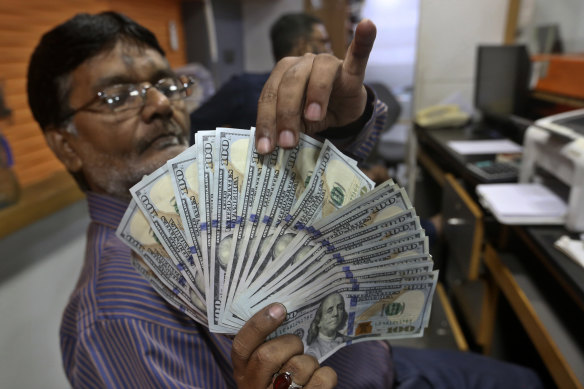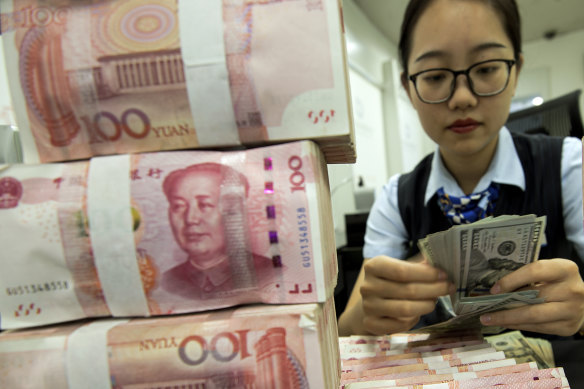The US dollar’s ‘imperial circle’ is a threat to the global economy
When Jerome Powell suggested this week that the US Federal Reserve Board was prepared to raise US interest rates faster and higher and keep them higher for longer it sent tremors through financial markets. It also sent an ominous message about the outlook for the global economy.
The Fed is already the most aggressive of the major central banks, having raised its federal funds rate by 450 basis points in the past 12 months and embarked on quantitative tightening (QT), or the withdrawal of liquidity from the US and global financial system by allowing the bonds and other securities it bought during the pandemic to mature without reinvestment. That QT program is running at $US95 billion ($144 billion) a month.

When the Fed tightens further and faster than the other major central banks, the US dollar appreciates, as it has been doing since the start of last month.
That was when financial markets started to realise that an expectation of a mid-year peak for US rates – that had been baked into bond and share prices – was misplaced, because US inflation has proven stickier than anticipated.
The dollar has strengthened about 4.4 per cent against the basket of its major trading partners’ currencies since the start of February. Over the same period the Australian dollar has depreciated about 7.5 per cent against the US dollar to trade below US66 cents for the first time since early November last year.
Dollar appreciation matters for the rest of the world because the dollar’s outsized role in the global financial system means its fluctuations have material implications for other economies, particularly (but not exclusively) the less developed economies.
Research by New York Fed economists published last week helps understand the extent to which the dollar drives global economic outcomes.
In a blog post entitled “The Dollar’s Imperial Circle” they describe the dollar as a procyclical force, with swings in its value governing global macro developments.
It is well understood that the dollar plays a role in global finance and trade that is disproportionate to the US share of the global economy.
The US contributes about 24 per cent of global GDP in nominal terms, or about 15 per cent in purchasing power parity terms. It is used, however, in about half of all trade invoicing, accounts for more than 60 per cent of official foreign exchange reserves and about 60 per cent of international and foreign currency liabilities are denominated in dollars. A third of the world’s countries peg their own currency to it and two-thirds of emerging market debt is denominated in dollars.

The NY Fed’s team argues that this outsized role in global financial activity is the first of two key asymmetries within the international monetary system.
The second is that the US economy is less exposed to movements in global trade than its trading partners.
While China, the euro area and some developing economies have significantly increased their exports relative to the size of their economies, the contribution of exports to the US economy has been lower and stagnant.
The researchers say that the dichotomy that the asymmetries represent – the role of the dollar in international trade and finance, and the exposure of the US economy to the global economy – creates the conditions for the dollar to act as a “self-fulfilling procyclical force.”
That could, of course, work in either direction. When there is a “hawkish” shift in the Fed’s monetary policies, however – as there is at present – it starts the more damaging “imperial circle” of a decline in global manufacturing because of the extent of dollar invoicing within the credit-intensive global value chain.
The contraction in global manufacturing, they say, eventually spills back into the US manufacturing because of production linkages and a reduction in foreign demand for US products. It also leads to falls in commodity prices and a decline in global trade.
Developing economies are hit hardest because the boost they get to their competitiveness from the depreciation of their currencies is more than offset by the higher US dollar-denominated costs of raw materials and debt and the impact of the capital outflows that occur when their currency weakens. The outflows reduce investment and are a destabilising influence on domestic economies and their financial systems.
The US – because it is less exposed to global trade – benefits in relative terms (albeit not necessarily in absolute terms) from a global economic decline, which the researcher say reinforces the imperial circle.
The role of the dollar within the global economy and financial system continues to attract criticism and attempts to blunt its impacts.

Its “weaponisation” to enforce sanctions against Russia, Iran, North Korea and, to a more limited extent, China, has caused controversy and created incentives for the development of alternatives.
China and Russia are trading directly in their own currencies and China has been trying to increase the share of its trade activity that is denominated in yuan, including recent efforts to convince (with some limited success) Middle Eastern oil producers to accept its currency.
Incumbency as the world’s reserve currency and the network benefits that confers, however, make it almost impossible to challenge the dollar’s position except in the very long term.
While China is the obvious (and aspiring) challenger, its aspirations are compromised by the presence of capital controls and the absence of a deep and liquid bond market. A lack of trust and transparency in its judicial system – a prerequisite for a reserve currency – is another major impediment.
When the Fed tightens further and faster than the other major central banks, the US dollar appreciates, as it has been doing since the start of last month.
China has blamed the US for flooding the global system with dollars during the pandemic, causing inflation to surge around the world and sparking currency depreciations and capital outflows that have harmed other economies, particularly emerging economies.
It’s hard to argue with that view, but the dollar’s dominance in the post-World War II period, which has been fundamental to globalisation of trade and finance, and helped China and other developing economies grow, has always carried with it some negative and potentially destabilising effects for the rest of the world.
If the Fed does what Powell indicated it was prepared to do in the absence of evidence that US inflation is cooling, the dollar’s procyclical role within the global economy – in this instance a likely contractionary influence – will transmit some of those negative and destabilising effects.
The Market Recap newsletter is a wrap of the day’s trading. Get it each weekday afternoon.
Most Viewed in Business
Source: Thanks smh.com